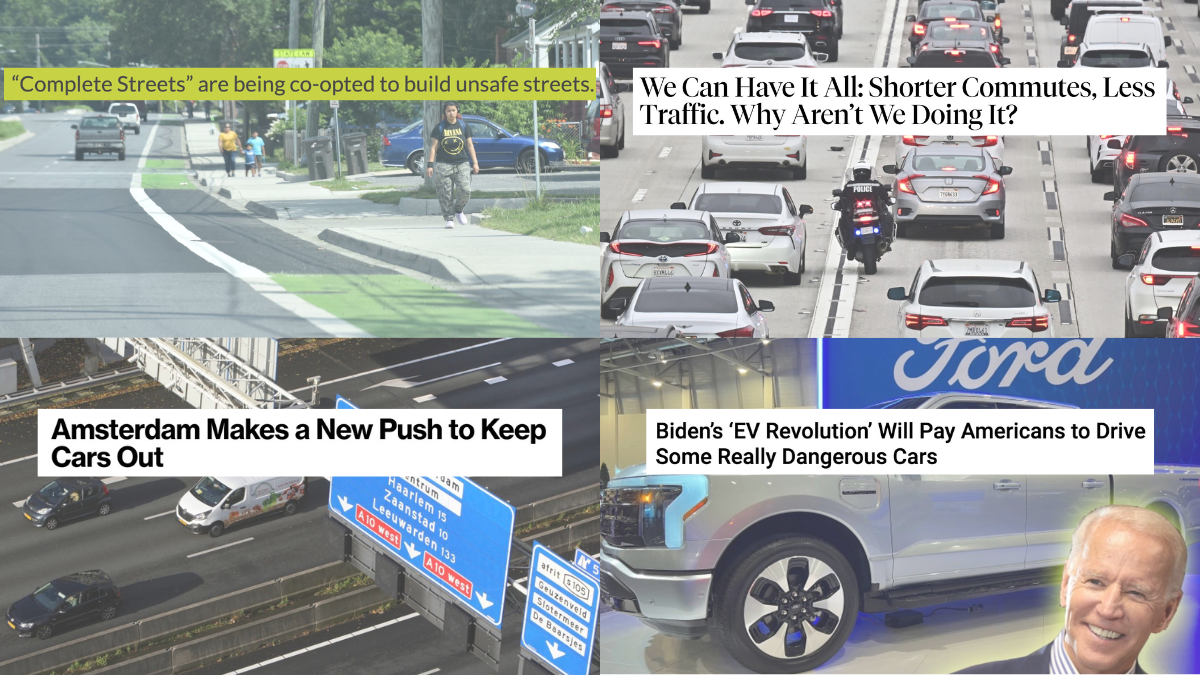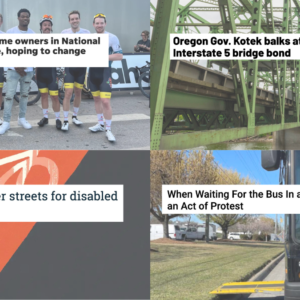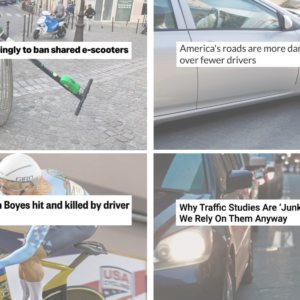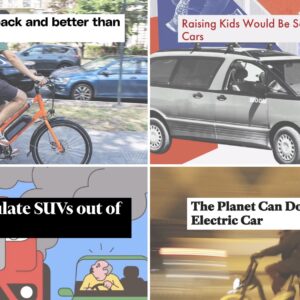Welcome to the week. Here are the most notable stories our writers and readers have come across in the past seven days…
**This week’s roundup is sponsored by The eBike Store, Portland’s original all-electric bike shop and the place for all things e-bike with brands like Tern, Specialized, Gazelle, and more..**
Expensive: Expect the freeway expansion industrial complex to tout the news that highway construction costs have ballooned 50% since December 2020 as yet another reason projects must be built ASAP. (Eno Center for Transportation)
Megacars: President Biden is bumbling his transportation and livability policies by paying Americans to buy heavy, dangerous, expensive “megacars” that will anchor us to terrible road safety and climate outcomes. (Streetsblog USA)
Central city diversion: City officials in Amsterdam understand that even a few cars in the central city muck things up so they are plotting to prohibit driving on some key through-routes. (Bloomberg)
Proximity (a.k.a. 15-minute city): The recent flap around “15-minute city” always seemed odd to me since we’ve talked its underlying principle of proximity since at least 2007. Either way, Doug Gordon offers this great summary of how it went sideways. (The New Republic)
Co-opting “complete streets”: Beware the DOT tactic of abusing terms to greenwash their projects. If cars dominate a street project, the project is incomplete because it effectively prohibits non-driving uses. (Smart Growth America)
Better buses, better cities: I can definitely relate to bus advocates who feel like their mode of transportation is too often overlooked as a powerful weapon in the fight against climate change. (Scientific American)
Blank check for freeway expansions: Economist and ODOT critic Joe Cortright has offered his breakdown of HB 2098 and he warns that it is full of vague terms that could saddle Oregon with debt for decades just to expand freeways. (City Observatory)
Figure this out: The square-wheeled bike is something you definitely have to see to believe. (Gizmodo)
Make plans now: I had no idea National Parks officials allowed bicycle riders to use many miles of roads in Yellowstone in a carfree environment before they are opened to the driving public. (Idaho Sun)
Biketown and bike counts: Don’t miss the OPB story on the Biketown expansion and the bike decline that featured little ol’ me being interviewed by local bike funnist (and new Weekend Edition host!) Lily Karabaic. (OPB)
Video of the Week: Was nice to see Portland Timbers put a star player on a bike for a promo, but it’s too bad it was just a promotional gimmick. (Would much rather see a Timber player rolling to a match on their own two wheels a la Golden State Warriors star Klay Thompson.)
Thanks to everyone who shared links this week.








Thanks for reading.
BikePortland has served this community with independent community journalism since 2005. We rely on subscriptions from readers like you to survive. Your financial support is vital in keeping this valuable resource alive and well.
Please subscribe today to strengthen and expand our work.
The car free roads in national parks isn’t limited to Yellowstone. At Glacier, Going to the Sun road is opened to cyclists for a few days (a week maybe? or maybe just a day?) before it opens/closes each spring/fall. Definitely something I’d like to do, especially since it’s possible to get there on the train. And at most parks that have roads closed to cars (Zion, Denali) you can ride a bike on them still.
But unfortunately, Amtrak still has pretty bad bike policies. Lots of routes severely limit (or outright ban) taking a bike. The Empire Builder doesn’t seem to have a limit for bikes at least, but some (the Coast Starlight) have a 4 bike max for seemingly no reason. This Streetsblog article highlights some of the issues for taking bikes on the train
There’s also Ride The Rim at Crater Lake, a little closer to home. Beautiful but brutal.
Nice catch. Sept 9th & 16th this year.
Ride the Rim Oregon |
You have to box your bike for the Empire Builder, which is why they have no limit. The 4-bike MAX on the Coast Starlight is for unboxed bikes. If you can’t snag one of those reservations, you can still bring a boxed bike.
And one word of caution on the Amtrak Long Distance routes: you can only do a boxed bike if your destination has baggage service. Essex, MT (south of Glacier) for example does not have this.
The Empire Builder between Portland and Spokane requires the boxing as there is no baggage car; Seattle to/from Spokane has the baggage car and bike hooks. On most east coast regional lines, only one bike per passenger car is allowed, as long as they have a hook, again because of a lack of baggage cars. There is a free 6-bike limit on the NC Raleigh to Charlotte trains (3 per day each way), not that anyone from Oregon would give a crap, with a similar limit on the NYC/Charlotte and the NYC/New Orleans trains.
I looked up the information for Glacier (Bicycling – Glacier National Park (U.S. National Park Service) (nps.gov). Springtime they close the road to autos for plowing but is open to Bikes check the above link for more details. From June 15 to Labor Day two sections of the Going to the Sun road closed to bicycle traffic from 11:00 am to 4:00 pm. From May 26 to Sept 10 vehicles must have a reservation to enter the park from 6:00 am to 3:00 pm. Getting a reservation is hard so at 3:00 pm the park is open to anyone. On my last visit this what we did and found the road was very crowded. So riding the road during the summer is not for the faint of heart. The good news is riding a bike into the park does not require a reservation and there are shuttle busses that travel the road and according to the web site most the shuttles have bike racks (pictures showed room for 2 bikes).
The Scientific American article on buses was a bit frustrating. Yes, it’s true that if buses are full of passengers they are more efficient, that if they run frequently they are better to use, and if they go where people want to go, people are more likely to ride them.
I am having a hard time imagining what achieving these conditions in Portland might look like. Very few buses I see have many passengers on them (this was less true pre-pandemic). Increasing frequency would make that problem worse (at least until a large influx of induced demand materialized, which it would, right?), and more frequency would require more drivers, which would greatly increase cost (if drivers who wanted to deal with driving buses could be found at all).
Do buses go where folks want to go? I live in one of the best connected parts of the city outside of downtown, and the answer for me is “occasionally”, especially for trips that are too long to easily bike. If I were open to spending a lot longer to travel by transferring once or twice, I could probably get that number up to “mostly”, but I’m generally not. Bike and car get me door to door when I want quickly and easily. My car is private and warm and can carry lots of things, and my bike is private and fun and gets me some exercise.
Finally, transit in Portland has no chance of working until it feels safer to ride. Right now it’s a real crapshoot — some rides are great, some feel like you’re one meth hit away from being stabbed.
I guess, like everything these days, our tolerance for letting sick people live in tents on the street is crowding out everything else we’d like to do.
Watts, sad but true. Last week, I took my partner into Portland (PSU area) for a work event (hers) plus dinner and drinks after. We missed our (early) CTRAN express bus home, last run. So jumped on the MAX out of habit. It was NOT a pleasure for her. Too many folks struggling with mental health issues etc. Even for me its was almost fight or flight, even with 20 years on the Yellow Line (and the old 6?). Just rode the BART into SF from SFO today and had a much better urban experience. BART even had a concierge at the Montgomery station public restrooms. Just say’in if Trimet wants to be a mobility resource for the choice rider into the 2030s.
It’s pretty easy for me to imagine how to get good transit in the Metro area. Triple or quadruple housing density along transit corridors. Lots of mid-rise apartments within a block or two of major streets, plus ADUs in a whole lot of basements and backyards within six blocks of frequent-service transit stops.
A massive increase in the housing supply will also go a long way to addressing safety perceptions. The high rate of homelessness is a direct result of a region-wide housing shortage. Get a lot more housing out there and the tents will vanish from the streets as the buses fill with new riders.
Basically, we don’t fix transit until we fix housing.
I don’t think this is even true. Portland could support a much better transit network, but TriMet does not really operate in the cities best interest for that. If you take a look at the ridership reports, almost all of the highest ridership routes are in Portland – while Washington/Clackamas county lag fairly far behind (there are exceptions – like the 57). But lots of the high ridership buses don’t actually get the investment/service they need to be genuinely great services – in some part because suburban areas need service too and they take up more resources (especially in $/per passenger mile).
I’m not super keen on things like “transit needs to make money” or “only profitable bus lines deserve service” – transit is a public good. But I do think that TriMet struggles to provide the sort of bus service that Portlanders deserve because of structural issues in the way that it was created and governed. In Seattle, there is a stark difference between the local (King County Metro) and regional (Sound Transit) transit providers – which allows the local service to be more intensive and more useful.
In cities where a regional authority governs anything, it almost always skews towards giving suburban fringes power over how the city runs its business. It’s an issue in New York, where Long Islanders refuse to upzone train station areas even after the MTA spent $11 billion on East Side Access. It’s an issue in Philadelphia, where SEPTA wasted years pursuing a spur route on the Norristown Highspeed Line in the suburban fringe rather than building the Roosevelt Subway. It’s an issue in Portland, where TriMet spends all of its planning prowess and $ on building light rail lines to suburbs rather than improving service within Portland proper.
In all of these cases, the issue is usually not the project itself in a vacuum – it’s the opportunity cost. And until Portland has a transit provider that actually centers the needs of the city itself, it will always be an uphill battle – even if we “fix” housing.
I think you have a very outdated idea of transportation needs. Most transportation systems were geared toward getting people into the central city/downtown area at peak commute times. Most, including Trimet, ignored people who live in suburbs or outer rings of cities that needed to get other places. In the Metro area, there is a lot of need for people to move around in the suburbs ( which incidentally, are urbanizing quite rapidly if you consider Hillsboro, Beaverton, Tigard etc. A lot of jobs are in the Westside suburbs and they are not well served by Trimet. The blue and redline are designed to get people into downtown ( and sadly not that quickly). People who want to move along the north-south axis in the western suburbs ( again, lots of jobs, lots of people, and a fairly urban development pattern starting to emerge) are really ignored.
If TriMet ran no service in Portland, it would not have the tax revenue or political support to exist at all. Portland is easily the most important transit market in the region – and not just downtown (the 72 is still the highest ridership bus in the region).
Lots of people need to move around the suburbs, but lots more need to move around Portland. And TriMet has not spent really any capital on anything other than “downtown peak hour commute” projects exactly because of Portland’s suburbanization. The entire regional focus has historically been on “reducing suburb to downtown commute time” because that’s what was perceived to be important by decision makers. Because that’s what suburban commuters wanted.
I think TriMet made the classically Oregon mistake of favoring short-term expediency over long-term benefit when they they did the MAX planning. The Max lines primarily run next to highways. The highways are significant barriers to development and pedestrians. That leaves the catchment almost cut in half. It is too late now, but more caps and bridges over freeways would help spur development and support transit by better capturing the existing density.
I’m not sure the fundamental limitations of transit can be solved by just building more apartments. Do people living on Division primarily want to travel downtown or to Gresham? Maybe. If so, we should be able to see the impacts of a dramatic increase in density along streets like SE Division on transit ridership along those corridors compared to areas that developed less.
I am not convinced that “corridors” are the future. I may be an outlier, but the places I like to go are not easily arranged in a line or concentrated in a central hub that makes using transit functional for my daily business.
Our current transit model feels quite dated, and I don’t see the “build it and they will ride” model working better for buses than it has for bikes. Buses definitely feel less like Coming Attractions and more like reruns of old episodes of the Jeffersons and One Day at a Time.
The “New Republic” link goes to the 2007 “proximity” article on this site.